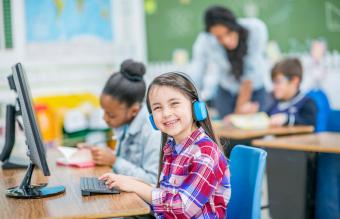
Different children learn differently, which is why you need classroom activities for multiple intelligences. Students who don't learn traditionally may be left behind by regular classwork. By engaging students in multiple intelligence activities that teach to each of the eight different types of intelligences, you will be able to help all of your students succeed.
Eight Multiple Intelligences
The theory of multiple intelligences posits that children have differing levels of eight different types of intelligence. Every child has at least one intelligence that is the strongest, and some believe teaching to those strengths can help students to be more successful. The eight multiple intelligences include the following:
- Verbal/linguistic
- Math/logical
- Spatial
- Musical
- Body/motion/kinesthetic
- Interpersonal
- Intrapersonal
- Naturalistic
Ideas for Classroom Activities for Multiple Intelligences
You can learn which type of intelligence a child has by testing then design classroom activities for multiple intelligences that play to each child's strength. Using multiple intelligence stations, or breaking children up into smaller groups according to their intelligence strengths, can help assure that each child is participating in activities that will help him learn.
Verbal/Linguistic Activities
Students with high verbal/linguistic intelligence are often well-spoken, and they write well. The following classroom activities favor this type of intelligence:
- Storytelling and narration
- Writing stories
- Create a television or radio newscast
- Create a newspaper
- Have a debate
- Play vocabulary games
- Create advertising materials for a made up business
- Create a classroom podcast
Math/Logical Activities
Students who have math/logical intelligence are logical thinkers who enjoy solving puzzles. Classroom activities that work well with this type of intelligence include the following:
- Solving mysteries using deductive reasoning
- Predicting outcomes based on circumstances
- Solving number or logic puzzles
- Doing financial planning for an imaginary business
- Use toys and images for sequencing games where kids have to show the right order
- Hide prizes, school supplies, or assignments in puzzle boxes
- Write secret messages in computer code
- Escape room or escape room kit such as Breakout EDU
Spatial Activities
Students with high spatial intelligence often think in pictures. They do well with art activities and spatial puzzles. Classroom activities to highlight spatial intelligence include the following:
- Art activities such as painting and play dough
- Working with play money
- Map reading and map making
- Play a Pictionary-style game
- Diagram sentences
- Pack specific items into a suitcase or box so they fit exactly
- Keep a bullet journal
- Use mind maps instead of traditional note-taking
Musical Activities
Children with high musical intelligence learn well through rhythm. They often enjoy musical activities. Classroom activities for musical intelligence include the following:
- Write and recite poetry
- Perform dance routines to act out historical or literary events
- Create songs or raps about math concepts
- Perform sound and vibration experiments in science
- Read picture books to the tune of music from different genres
- Make up song memory devices for different subjects
- Write test or worksheet answers on the beat of a metronome
- Practice spelling words with a classroom orchestra where each kid makes a different sound with their body while reciting a spelling word

Kinesthetic Activities
Kinesthetic learners love motion. They are often very physical children and sometimes gifted athletes. Activities for kinesthetic learners include the following:
- Dramatic re-enactments of historical or literary events
- Using different body parts to measure objects
- Use charades to act out parts of speech
- Learn folk dances that represent different cultures
- Design and build an architectural model out of materials like Popsicle sticks or toothpicks
- Use Lego bricks for math lessons such as the different sized bricks for fractions
- Tell a story or practice vocabulary words with yoga poses attached to each word
- Make up fingerplays to study for tests
Interpersonal Intelligence Activities
Interpersonal learners are those children who work well cooperatively and thrive on building friendships and relationships. Activities to teach interpersonal learners include the following:
- Working in small groups on a project
- Mentoring or teaching concepts to another student
- Conducting interviews
- Role-playing historical or literary situations
- Team-building exercises
- Cooperative or team video games
- Board or card games that involve creating alliances
- Mock political campaigns and elections
Intrapersonal Activities
Intrapersonal learners are those who are very aware of their own motivations. They often have a high level of self-awareness and emotional intelligence. Intrapersonal classroom activities include the following:
- Keep a journal
- Write an autobiography
- Work independently
- Write essays about which historical or literary figures they would want to be
- Rewrite a story from their point of view
- Share how they'd be different if they were from another culture
- Multi-player role-play games such as Dungeons and Dragons where each kid is their own character
- Meditation sessions for brainstorming or studying
Naturalist Activities
Naturalists are nature lovers who often have an excellent understanding of or interest in earth sciences. Activities for naturalist learners include the following:
- Categorize species in the natural world
- Collect items from nature
- Go on nature walks
- Orienteering
- Math story problems featuring plants or animals
- Classroom pets
- Plant and maintain a community garden
- Host a community nature clean-up event
Engage the Whole Child
You don't have to back the multiple intelligences theory to see the value in engaging the whole child in lessons and activities. Look for brain game activities that incorporate at least a few of the listed types of intelligence to create a fully immersive experience for your class.







